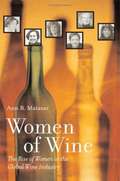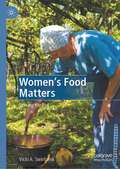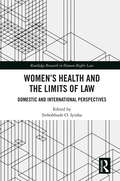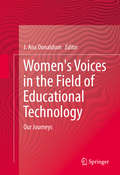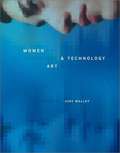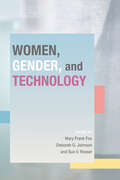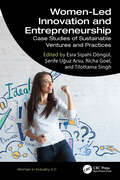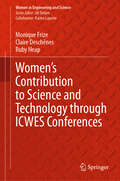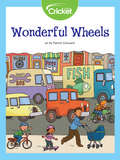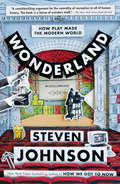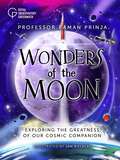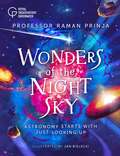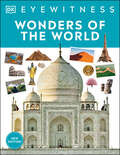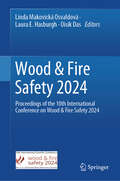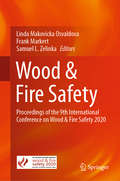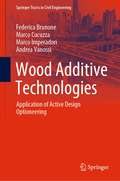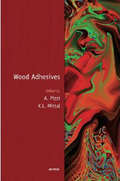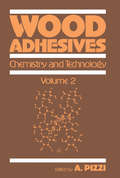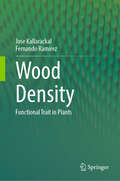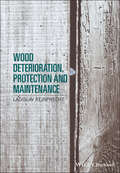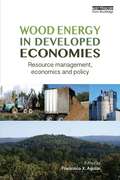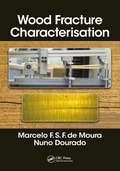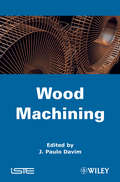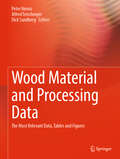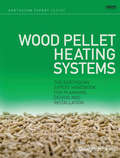- Table View
- List View
Women of Wine: The Rise of Women in the Global Wine Industry
by Ann B. MatasarThis book explores womens' increasingly influential role in the wine industry, traditionally a very male-dominated domain. Women of Wine draws on interviews with dozens of leading women winemakers, estate owners, professors, sommeliers, wine writers, and others in the United States, the United Kingdom, France, Italy, Australia, New Zealand, and elsewhere to create a fascinating mosaic of the women currently shaping the wine world that also offers a revealing insiders' look at the wine industry.
Women's Food Matters: Stirring the Pot
by Vicki A. SwinbankWomen have always been inextricably linked to food, especially in its production and preparation. This link, which applies cross-culturally, has seldom been fully acknowledged or celebrated. The role of women in this is usually taken for granted and therefore often rendered unimportant or invisible. This book presents a wide-ranging, interdiscplinary and comprehensive feminist analysis of women’s central role in many aspects of the world’s food systems and cultures. This central role is examined through a range of lenses, namely cross-cultural, intergenerational, and socially diverse.
Women's Health and the Limits of Law: Domestic and International Perspectives (Routledge Research in Human Rights Law)
by Irehobhude O. IyiohaDespite some significant advances in the creation and protection of rights affecting women’s health, these do not always translate into actual health benefits for women. This collection asks: 'What is an effective law and what influences law’s effectiveness or ineffectiveness? What dynamics, elements, and conditions come together to limit law’s capacity to achieve instrumental goals for women’s health and the advancement of women’s health rights?' The book presents an integrated, co-referential and sustained critical discussion of the normative and constitutive reasons for law’s limited effectiveness in the field of women’s health. It offers comprehensive and cohesive explanatory accounts of law’s limits and for the first time in the field, introduces a distinction between formal and substantive effectiveness of laws. Its approach is trans-systemic, multi-jurisdictional and comparative, with a focus on six countries in North America, Europe, Asia, and Africa and international human rights case law based on matters arising from Hungary, Portugal, Spain, Slovakia, the Czech Republic, Peru and Bolivia. The book will be a valuable resource for educators, students, lawyers, rights advocates and policymakers working in women’s health, socio-legal studies, human rights, feminist legal studies, and legal philosophy more broadly.
Women's Voices in the Field of Educational Technology
by J. Ana DonaldsonIn a professional world that has a tradition of the "good old boy" network, women long have fought for recognition in the educational technology field. In this book authors discuss the women in their own lives who have made the difference for them in their professional development. A group of 31 individuals from the USA, Canada, Northern Cyprus, the UK, and South Korea were asked to be part of this endeavor. The breadth of the list was intended to bring together as many perspectives as possible. Some stories included in this book are deeply private, others offer historical perspectives of women's roles in educational technology, while others focus on mentoring. This book is intended as a resource for all individuals in the field of educational technology, instructional design, and learning design at a national and international level.
Women, Art, and Technology
by Judy MalloyAlthough women have been at the forefront of art and technology creation, no source has adequately documented their core contributions to the field.
Women, Gender, and Technology (Women Gender and Technology)
by Judy Wajcman Sue V. Rosser Barbara Katz Rothman Carol Colatrella Mary Frank Fox Mara H Wasburn Susan G Miller Cheryl B Leggon Linda L Layne James FenimoreAn interdisciplinary investigation of the co-creation of gender and technology Each of the ten chapters in Women, Gender, and Technology explores a different aspect of how gender and technology work--and are at work--in particular domains, including film narratives, reproductive technologies, information technology, and the profession of engineering. The volume's contributors include representatives of over half a dozen different disciplines, and each provides a novel perspective on the foundational idea that gender and technology co-create one another. Together, their articles provide a window on to the rich and complex issues that arise in the attempt to understand the relationship between these profoundly intertwined notions.
Women-Led Innovation and Entrepreneurship: Case Studies of Sustainable Ventures and Practices (Women in Industry 4.0)
by Richa Goel Tilottama Singh Esra Sipahi Döngül Şerife Uğuz ArsuThere is a glaring lack of recognition for the contributions of women to innovation, entrepreneurship, and sustainable development in literature. This book seeks to address this gap by highlighting the often-overlooked accomplishments of women in these crucial fields.Women- Led Innovation and Entrepreneurship: Case Studies of Sustainable Ventures and Practices features interviews with industry thought leaders and experts, providing exclusive insights into the changing role of women in driving sustainable development through innovation. The book offers a range of resources, including checklists and tools, designed to foster a supportive environment and offer practical advice and strategies for aspiring entrepreneurs and innovators. It outlines actionable steps for implementing sustainable practices and provides valuable insights that can be applied in the real world. Furthermore, this book presents in-depth case studies of women from various industries and regions, showcasing their innovative ventures, strategies, and how they have overcome obstacles to achieve success in entrepreneurship while promoting sustainability.It serves as a valuable reference for academics, policymakers, and professionals interested in exploring the intersection of gender, innovation, entrepreneurship, and sustainable development.
Women’s Contribution to Science and Technology through ICWES Conferences (Women in Engineering and Science)
by Monique Frize Claire Deschênes Ruby HeapThis book discusses the legacy of the conference series The International Conferences of Women Engineers and Scientists (ICWES), which spans the second half of the Twentieth Century and the beginning of the twenty-first. The book first discusses how, at a time when there were few women engineers and scientists, a group of women organized a conference, in June 1964 in New York, which attracted 486 women. They presented their scientific achievements and discussed how to attract more women in STEM. This effort was carried out by volunteers, continuing the ICWES conferences over a period of 59 years. The authors discuss the organizers, the hosting societies, the scientific content, the changes in issues over time, and how the continuity has endured. The authors also discuss the importance of global involvement, shown through past conferences in locations such as USA, UK, Italy, Poland, France, India, Ivory Coast, Hungary, Japan, Canada, and Korea. The authors also outline how the efforts were aided by the development of a not for profit Canadian corporation, the International Conference of Women in Sciences and engineering (INWES), which ensures the continuation of the conference series. Claire Deschênes and Monique Frize ensured that the conference database was digitalized and is now available at the Canadian Archive of Women in STEM, University of Ottawa Library, with the hope that researchers will continue to explore this rich database. As an important part of the Women in Science and Engineering book series, the work hopes to inspire women and men, girls and boys to study and work in STEM fields. This book is important historically because it documents a unique adventure created by women in STEM through vision and leadership. Their efforts established modes of networking and sharing their contributions in science, technology, and on gender issues.
Wonderful Wheels
by Amy TaoWanda Wheel presents the captivating history of wheels, and their influence on civilization.
Wonderland: How Play Made the Modern World
by Steven JohnsonFrom the New York Times-bestselling author of How We Got to Now and Where Good Ideas Come From, a look at the world-changing innovations we made while keeping ourselves entertained. This lushly illustrated history of popular entertainment takes a long-zoom approach, contending that the pursuit of novelty and wonder is a powerful driver of world-shaping technological change. Steven Johnson argues that, throughout history, the cutting edge of innovation lies wherever people are working the hardest to keep themselves and others amused. Johnson's storytelling is just as delightful as the inventions he describes, full of surprising stops along the journey from simple concepts to complex modern systems. He introduces us to the colorful innovators of leisure: the explorers, proprietors, showmen, and artists who changed the trajectory of history with their luxurious wares, exotic meals, taverns, gambling tables, and magic shows. Johnson compellingly argues that observers of technological and social trends should be looking for clues in novel amusements. You'll find the future wherever people are having the most fun.From the Hardcover edition.
Wonders of the Moon: Exploring the greatness of our cosmic companion
by Professor Raman PrinjaThe must-have read for the next generation of Moon-landers, from international-award-winning author Professor Raman Prinja, Jan Bielecki and Royal Observatory Greenwich - explore the science of our cosmic companion and the wonder of how we get there.For the first time in over 50 years, humans are setting foot on the Moon again. Wonders of the Moon is the perfect companion for this historic moment, filled with key science learning as well as up-close details of the Moon and the amazing tech that carries us there. From the Artemis missions, to the enormous potential of the vast swathes of water ice on the Moon, readers age 9+ will learn so much about the brightest light in their night sky. The book is part of a visually stunning series that takes an authoritative look at fascinating topics, including: Wonders of the Night Sky / The Future of the Universe / The Wonders of Time / Wonders of the Mind
Wonders of the Night Sky
by Raman PrinjaInviting all who dare to wonder - come navigate the spectacular treasures of the night sky with bestselling and award-winning Professor Raman Prinja's inspiring look into our galaxy and beyond, published in association with Royal Observatory Greenwich.Encourage your kids to reach for the stars with this inspiring exploration of the night sky. Anyone with a view of the sky and a curious mind can be the next great Universe explorer!Wonders of the Night Sky invites children all over the world to look up - just as curious people before them have done for millennia - and to know why each wonder appears before their eyes. This beautiful book connects readers to the many parts of our Universe visible to the naked eye against the sky, explodes them on the page, then provides inspiring connections to the science behind the stellar backdrop. Professor Raman Prinja is the multi-award-winning Head of Department for Physics and Astronomy at University College London and a celebrated children's author. Professor Prinja pens this definitive look at the wonders above us, following on from the enormous success of his book Planetarium. Illustrator Jan Bielecki's striking depiction of each natural marvel will draw in readers to a lifetime of astronomical wonder. Astronomy starts with just looking up!If you like this, you'll also love the follow-up book, The Future of the Universe. Take what you've learned about the Universe and rocket trillions of years ahead in time to find out some amazing changes to come...
Wonders of the World (DK Eyewitness)
by DKDiscover the astounding ancient architecture, the history of civilization, and the beauty of our planet in these Wonders of the World.Become an eyewitness to the fascinating architectural feats and natural treasures of the world in this picture-led reference guide that will take you on a visual tour of more than 50 wonders of the world. Children will be mesmerized by human-made landscapes such as the Statue of Liberty to record-breaking natural marvels like the River Nile. This unique, beautifully illustrated guide takes kids on an incredible journey around the world's most spectacular sights. Using striking full-color photographs and illustrations, discover the Pyramids of Giza, the Hanging Gardens of Babylon, the Temple of Artemis, the Statue of Zeus, the Mausoleum atHalicarnassus, the Colossus of Rhodes, and the Lighthouse of Alexandria and much more!Throughout the pages of this newly-revised book on Wonders of the World, you can expect to find: - A fresh new look, new photographs, updated information, and a new &“eyewitness&” feature- Amazing facts, diagrams, statistics, and timelines- Brand new eyewitness accounts from experts in the fieldEyewitness Wonders of the World introduces the ultimate guide to remarkable architecture and natural wonders. Children can learn about the most incredible natural and human-made wonders, through amazing facts, diagrams, and statistics to see them as never before. This all-emcompassing wonders of the world guide is a must-have for curious children aged 9+ with a thirst for learning, as well as teachers, parents and librarians.So, what&’s new? Part of DK&’s best-selling Eyewitness series, this popular title has been reinvigorated for the next generation of information-seekers and stay-at-home explorers, with a fresh new look, up to 20 percent new images, including photography and updated diagrams, updated information, and a new &“eyewitness&” feature with fascinating first-hand accounts from experts in the field.Explore the series!Globally, the Eyewitness series has sold more than 50 million copies over 30 years. Journey down the River Amazon and explore the rainforest with Eyewitness Amazon, learn how to combat climate change with Eyewitness Climate Change or take a trip aboard the most famous ship in history with Eyewitness Titanic.
Wood & Fire Safety 2024: Proceedings of the 10th International Conference on Wood & Fire Safety 2024
by Oisik Das Linda Makovická Osvaldová Laura E. HasburghThis proceedings volume presents new scientific works of the research workers and experts in the field of Wood Science & Fire.It looks into the properties of various tree species across the continents affecting the fire-technical properties of wood and wood-based materials, its modifications, fire-retardant methods and other technological processes that have an impact on wood ignition and burning. The results of these findings have a direct impact on Building Construction and Design describing the fire safety of wooden buildings, mainly large and multi-story ones. The results of these experiments and findings may be applied, or are directly implemented into Fire Science, Hazard Control, Building Safety which makes the application of wood and wood materials in buildings possible, while maintaining strict fire regulations.One part of the contributions focuses on the symbiosis of the material and the fire-fighting technologies. Wood burning has its own specific features, therefore, the fire protection technologies need to be updated regularly. It also includes the issue of the intervention of fire-fighting and rescue teams in the fires of wooden buildings. Presentations deal with the issue of forest fires influenced by the climate changes, relief, fuel models based on the type and the age of the forest stand.
Wood & Fire Safety: Proceedings of the 9th International Conference on Wood & Fire Safety 2020
by Linda Makovicka Osvaldova Frank Markert Samuel L. ZelinkaThis proceedings volume presents new scientific works of the research workers and experts from the field of Wood Science & Fire.It looks into the properties of various tree species across the continents affecting the fire-technical properties of wood and wood-based materials, its modifications, fire-retardant methods and other technological processes that have an impact on wood ignition and burning. The results of these findings have a direct impact on Building Construction and Design describing the fire safety of wooden buildings, mainly large and multi-story ones. The results of these experiments and findings may be applied, or are directly implemented into Fire Science, Hazard Control, Building Safety which makes the application of wood and wood materials in buildings possible, while maintaining strict fire regulations.One part of the contributions focuses on the symbiosis of the material and the fire-fighting technologies. Wood burning has its own specific features, therefore, the fire protection technologies need to be updated regularly. It also includes the issue of the intervention of fire-fighting and rescue teams in the fires of wooden buildings. Presentations deal with the issue of forest fires influenced by the climate changes, relief, fuel models based on the type and the age of the forest stand.
Wood Additive Technologies: Application of Active Design Optioneering (Springer Tracts in Civil Engineering)
by Marco Imperadori Federica Brunone Marco Cucuzza Andrea VanossiThe book encodes a vision for the actively sustainable management and development of the built environment by referring to the application of timber-based construction systems as additive solutions for the multi-purpose improvement of existing buildings. It translates this vision into an innovative methodology for the management of the entire building process – from design to production, operation, and maintenance - and the assessment of timber-based construction performances across the whole building life-cycle. This approach is based on a multi-dimensional analysis, which starts from the structure of the Active House (AH) protocol, improved through information-integrated digital environments and multi-criteria evaluation methods, such as BIM and Design Optioneering. During the design stage, indeed, it analyzes and compares different design choices, according to the DO method, until the definition and validation of the “As-Built” step, while in the operational phase, it refers to sensors-retrieved data to show the evolution of the building behaviour, accounting for real users’ interaction, building performances decay and needs of maintenance, defining the digital twin of the building: a real Cognitive Building. Finally, the application of this methodology identifies innovative models of processes, products, and design of wood-based construction technologies, suitable to satisfy the needs of the 2D/3D construction layering for the sustainable transformation of the built environment.
Wood Adhesives
by K. L. Mittal A. PizziWood adhesives are of tremendous industrial importance, as more than two-thirds of wood products in the world today are completely or partially bonded together using a variety of adhesives. Adhesive bonding offers many advantages over other joining methods for wood components, and there has been a great deal of R& D activity in devising new woo
Wood Adhesives: Chemistry and Technology---Volume 2
by A. PizziThe perfect companion to the highly acclaimed Volume 1 of Wood Adhesives,Volume 2 presents stimulating discussions on technically and economically importantadhesives for wood bonding-covering their preparation and formulation, as well astechniques and suggestions for their application.Like its companion book, Wood Adhesives, Volume 2 provides up-to-date informationand analysis of new technologies and recent breakthroughs ... gives insightinto the relationship between adhesive chemistry and technical application . . . anddiscusses present and future trends likely to have considerable impact on the field.Elaborating upon general overviews presented in Volume 1, Wood Adhesives,Volume 2 includes a chapter on protein adhesives ... fills the gap on the chemistryof polyvinyl acetate wood adhesives ... contains a detailed discussion of formaldehydeemission ... and much more.A complementary and much needed follow-up to Volume 1, Wood Adhesives,Volume 2 is essential reading for wood technologists; adhesives and physicalchemists; forest products researchers; polymer scientists; chemical, mechanical, process,and civil engineers who must choose and apply wood adhesives; and advancedundergraduate and graduate students in the above disciplines.
Wood Density: Functional Trait in Plants
by Fernando Ramírez Jose KallarackalRecent research has shed light on the crucial role of wood density, a fundamental physical property, as a functional trait. This means wood density isn't just about how much a piece of wood weighs, but how it influences a plant's entire strategy for survival and growth. While variations exist between individual species, a surprising trend has emerged: the majority of this variation can be traced back to a plant's genus or even family. This strong phylogenetic signal indicates that wood density is a deeply ingrained characteristic, shaped by a plant's evolutionary history. This newfound understanding allows us to leverage wood density as a taxon-based functional trait. By considering the typical wood density of a plant group (like a genus or family), we can improve models and predictions related to various ecological and functional aspects in forests and plantations. Over the past couple of decades, scientists have been actively exploring the connections between wood density and a wide range of plant functions. Denser wood is often linked to slower growth rates, delayed reproduction, and increased mechanical strength. It also influences a plant's ability to transport water, resist death (mortality rate), and manage internal water balance (water potential). Additionally, wood density is closely tied to physiological aspects such as gas exchange and xylem hydraulic conductance, which are crucial for nutrient and water movement. Wood density is also an important parameter to determine the carbon sequestration capacity of a tree or vegetation, thus important in climate change research. This proposed book will delve into these fascinating connections, highlighting how wood density acts as a key player in shaping the lives of plants and the overall health of forest ecosystems.
Wood Deterioration, Protection and Maintenance
by Ladislav ReinprechtWood Deterioration, Protection and Maintenance provides an up to date discussion of the natural durability of wood, wood degradation processes, and methods of structural and chemical protection of wood. Modern active substances in wood preservatives and the relationships between preservative properties, the anatomical structure and moisture content of wood and protective processes involving pressure and/or diffusion driving forces are fully illustrated.
Wood Energy in Developed Economies: Resource Management, Economics and Policy
by Francisco X. AguilarThere has been a recent resurgence of interest in wood energy as part of a sustainable range of renewable energy options. This book addresses the current gap in the energy and public policy literature for a reference book that compiles the most-recent wood energy assessments, and evaluates current and potential future wood energy uses and the role for public policy to foster efficient use of the most-widely consumed renewable energy in the world. It brings together a group of expert authors covering topics from forest management, operations and engineering, to socio-economics and energy policy perspectives. It thus covers practical issues such as silviculture, harvesting, processing, comparative cost estimates, public policy tools and market effects. As such the book provides a comprehensive review of the complex dimensions of wood energy as well as practical guidance for professionals, researchers and advanced students. It will also provide invaluable guidance for economic development agencies, practitioners and policy-makers, when evaluating the impacts of wider wood energy adoption as part of a strategy for sustainable energy generation. The main focus is on industrialised production and developed economies, particularly the USA and Europe.
Wood Fracture Characterization
by Nuno Dourado Marcelo F. de MouraWood Fracture Characterization provides a guide to the application of modern fracture mechanics concepts to wood materials used in structural engineering, which commonly involve discontinuities and irregularities. The authors cover the tests, data reduction schemes and numerical methods devised for wood structural applications, based on cohesive zone analysis, and used to validate experimental-based methodologies. Five detailed Case Studies are included to link theory with engineering practice. This important new text explains the basics of fracture mechanics, and extends them as needed to cover the special behaviour of an anisotropic wood materials.
Wood Machining
by J. Paulo DavimWood as an engineering material can be technically defined “as a hygroscopic, orthotropic, biological, and permeable material having extreme chemical diversity and physical complexity with structures, that vary extensively in their shape, size, properties and function”. Therefore, using wood to its best advantage and most efficiency in engineering applications, specific characteristics or chemical, physical and mechanical properties must be considered. The products are divided into two classes, solid wood and composite wood products. Solid wood includes shipbuilding, bridges, flooring, mine timbers, etc. Composite wood products include insulation board, plywood, oriented strand board, hardboard and particle board. In recent years, the machining of wood products has acquired great importance due the short supply of wood and increasing environmental awareness among users and manufacturers. The optimization of the machining process centers around the mechanism of chip formation, tool wear, workpiece surface quality, crack initiation and propagation of different types of wood. Other factors are also humidity, temperature, static preloads, and vibrations that can affect the wood during the machining process. The book provides some fundamentals and recent research advances on machining wood and wood products.
Wood Material and Processing Data: The Most Relevant Data, Tables, and Figures
by Dick Sandberg Peter Niemz Alfred TeischingerThe book is intended for professionals in the field of materials science, construction technology and operational design of new facilities. Characteristic values for the calculation, project planning and process optimization are often important for the engineer working in the project planning of plants. Therefore, characteristic values for solid wood from different continents and for wood-based materials and modified wood are compiled in tabular form. Important adhesives and coating materials complete the collection of characteristic values. Standards from Europe, the USA, Russia and China are also listed. Information on material consumption, energy consumption and material utilization are also included (sawn wood, wood based material, pulp and paper). Other important information and a list of specialist books complete the data collection. The data supplement the knowledge in existing specialist books and compendiums in the field of wood science and wood technology, with a large numberof specific details that are only briefly compiled in specialist articles or specialist books.
Wood Pellet Heating Systems: The Earthscan Expert Handbook on Planning, Design and Installation (Earthscan Expert Ser.)
by Dilwyn JenkinsWood Pellet Heating Systems is a comprehensive handbook covering all aspects of wood pellet heating technology. The use of wood pellets as an alternative heating fuel is already well established in several countries and is becoming widespread as fossil fuel prices continue to rise and awareness of climate change grows. Wood pellets are a carbon-neutral technology, convenient to use, and can easily be integrated into existing central heating systems or used in independent space heaters. This fully-illustrated and easy-to-follow guide shows how wood-pellet heating works, the different types of systems – from small living room stove systems to larger central heating systems for institutions – how they are installed, and even how wood pellets are manufactured. Featuring examples from around the world, it has been written for heating engineers and plumbers who are interested in installing systems, home owners and building managers who are considering purchasing a system, advanced DIYers, building engineers and architects, but will be of interest to anyone who requires a clear guide to wood pellet technology.
